Adromischus fallax
Adromischus fallax Toelken
Family: Crassulaceae
Common names: large cliff-adromischus (Eng.); groot-kransrosie, groot-kransnenta (Afr.)
Introduction
Adromischus fallax is a rare, cliff-hugging, occasionally pendent, leaf and stem succulent from the southern escarpment margin near Graaff Reinet in the Eastern Cape, flowering in summer. The plants have a tendency to sprawl, forming loose clusters. The leaves are greenish, sometimes mottled purplish. The inflorescence with yellowish-green, tubular flowers, the lobes reddish-purple. Best grown in containers and hanging baskets.
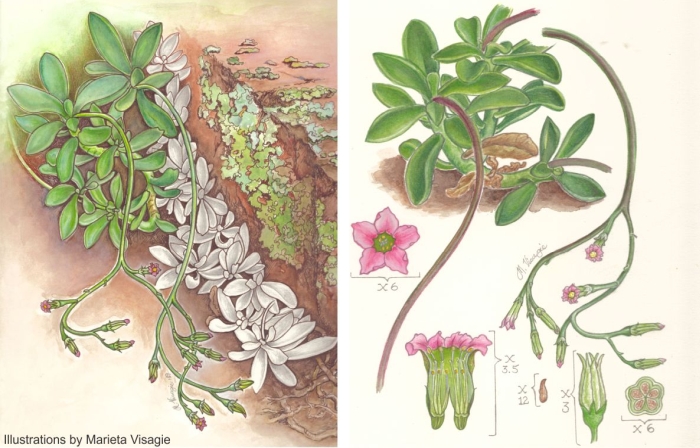
Fig. 1. Illustrations of a flowering cluster of Adromischus fallax by Marieta Visagie, the plants from Groenfontein, Graaff-Reinet, Eastern Cape.
Description
Description
Plants low-growing, forming loose clusters or mats. Roots fibrous. Branches decumbent, flaccid, up to 200 mm long, 4–8 mm in diameter, sometimes drooping. Leaves sometimes arranged in an apical rosette, 20–50 × 8–20 mm, oblanceolate to elliptic, spreading, soft, greyish-green, immaculate, rarely with purple spots; upper surface concave; lower surface rounded and blunt to pointed at the tip; base wedge-shaped. The inflorescence consists of a thyrse, 100–300 mm tall, bearing 1–5 flowers; pedicel 5–15 mm long. Calyx up to 4–5 mm long. The corolla tubular, 10–13 mm long, funnel-shaped, the lobes triangular-ovate, up to 3.0–4.5 mm long, pink to white, with club-shaped trichomes in throat; apices acute. Anthers included. Flowering is mainly in midsummer (January to February, southern Hemisphere).
Conservation Status
Status
Adromischus fallax is classified as Rare but not threatened in the Red List of South African Plants. It is a habitat specialist with a restricted range but is locally common and well protected by its difficult to reach, cliff habitat, and its distribution falls within a greater conservation region.
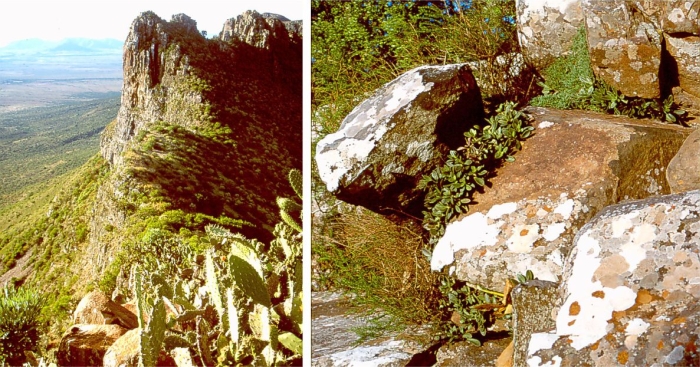
Fig. 2. Tandjiesberg, Graaff-Reinet, the habitat of Adromischus fallax and a cluster of plants growing amongst dolerite boulders on the Tandjiesberg, note the numerous lichens which grow in abundance because of the moist air.
Distribution and habitat
Distribution description
Plants are only known from the Graaff-Reinet region growing on sheer, south-facing cliffs at 1 200–500 m altitude, along the southern escarpment edge. Adromischus fallax grows rooted in crevices. The depicted plants were photographed both on the Tandjiesberg and Groenfontein, east of Graaff Reinet, growing on ledges on sheer cliffs near the escarpment top.
The average daily maximum temperature is about 23°C and the average daily minimum about 8°C. Temperatures are high in summer (30°C). Winters are cooler but with occasional frost or snow. Rainfall occurs mainly in summer, with a peak in spring and autumn, and also with occasional cold fronts in winter. The average rainfall ranges from 300–400 mm per annum, mainly in the form of thunder showers and to a lesser extent, cyclonic winter rain. The geology consists of Beaufort shales (Adelaide Subgroup, Karoo Supergroup). The associated vegetation consists of Camdebo Escarpment Thicket of the Albany Thicket Biome (Mucina et al. 2005). On the Tandjiesberg near Graaff-Reinet, the following species have been recorded: Cotyledon orbiculata var. orbiculata, Crassula exilis subsp. cooperi, C. lanceolata subsp. lanceolata, C. nemorosa and C. perforata, Delosperma spp., Drimia uniflora and Haemanthus humilis subsp. hirsutus. At Groenfontein north east of Graaff Reinet plants were found growing at the base of shrubs on ledges on the upper escarpment margin. Associated species include: Crassula nudicaulis, C. pellucida subsp. marginalis, C. lanceolata, C. tetragona subsp connivens and C. sarcocaulis, Aloiampelos striatula, Haemanthus albiflos, Pelargonium zonale and the shrub Diospyros whyteana.
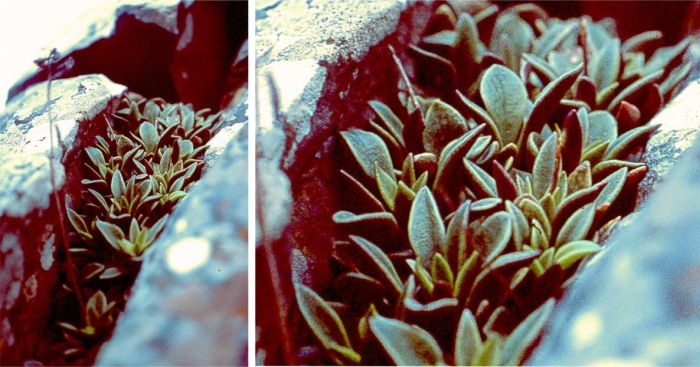
Fig. 3. Adromischus fallax filling a crevice on cliffs on the Tandjiesberg, near Graaff-Reinet, Eastern Cape.
Derivation of name and historical aspects
History
The genus name Adromischus is derived from the Greek adros, meaning ‘thick’ and mischos, meaning ‘a stalk’. Adromischus fallax was named in the botanical magazine Bothalia in 1978 by Helmut Toelken (1939–), former South African botanist who settled in Australia in 1979 (Gunn & Codd 1981), from plants first collected by Bolus near Graaff-Reinet. The Latin species name fallax, means ‘deceptive’, and perhaps pertains to its position within the related Adromischus species. Helmut revised the southern African Crassulaceae in 1985 for the Flora of South Africa.
Adromischus fallax is one of six Adromischus species that belongs in section Brevipedunculati. For additional information see Adromischus humilis.
Adromischus fallax comes closest to A. humilis, a smaller species from the Escarpment Mountains between Beaufort West and Sutherland. The latter forming tight cushions with mottled rosettes. The branches of A. fallax tend to elongate and are often drooping from the cliffs.
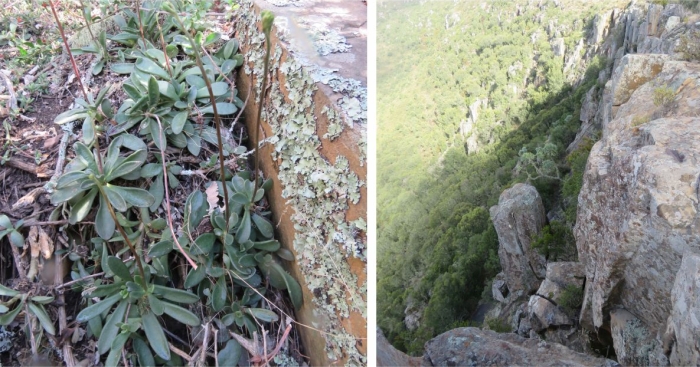
Fig. 4. The cliffs at Groenfontein on the Escarpment north-east of Graaff-Reinet, Eastern Cape, and a cluster of Adromischus fallax trailing along the rock face on a cliff at Groenfontein. Note the lichens, a result of moist air in its habitat.
Ecology
Ecology
Adromischus fallax proliferates from subterranean stolons. Plants are relatively fast growing, forming loose clusters, with leaves crowded at the apices often forming loose rosettes. Branches rooting where they touch ground. The plants are conspicuous on the cliff face, often filling an entire ledge or crevice. The very swollen nature of the stems and leaves reflects their ability to store moisture on the extreme, well-drained cliffs. The long, extended stems trail along the ledges, often becoming pendent. The stems are grey-green, up to 10 mm in diameter and grow to about 300 mm long, sometimes drooping from the cliff face. These long stems can be viewed as an adaptation to the cliff habitat, giving the plant a vegetative propagation back-up plan, allowing it to colonise new crevices.
The tubular flower has pink lobes, and is pollinated by insects. The seeds are minute and ideal for establishment in crevices. The fruiting capsules are dehiscent, with seeds spontaneously released and dispersed by wind. Seeds are released in autumn in time for the autumn rains, and thus maximising establishment.
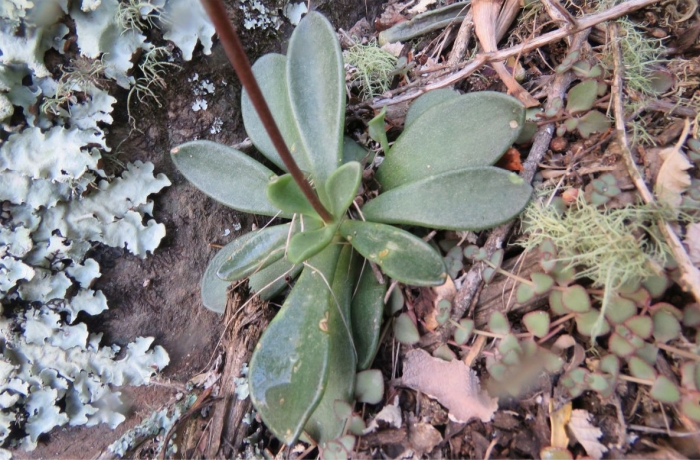
Fig. 5. A solitary branch of Adromischus fallax on the cliffs at Groenfontein.
Growing Adromischus fallax
Grow
Adromischus fallax is usually easily grown and is becoming popular as a pot plant in cultivation and can be grown more or less under the same conditions as A. humilis in the same series. It is easily cultivated, its vigour maximising survival.
It grows best in light shade, in a sandy-loam to loamy soil. Plants rapidly respond to watering, becoming turgid and filling the containers. Keep dry or water very sparingly during winter. Plants can be fed with an organic fertiliser throughout the year. It’s very easy growing nature maximises its survival rate. Plants adapts well to containers. A. fallax as well as A. humilis are resistant to light frosts.
Because of the competition from plant roots, it is best suited for containers, preferably ceramic. It can also be grown with other succulents in miniature succulent gardens where conditions can be controlled. Grow in a sandy loam soil which drains well. Plants are easily propagated by division or stem cuttings from spring to late summer. Avoid too much watering because plants tend to rot. Its main growing season is during summer. Water should be provided sparingly. A rapidly dividing plant, forming dense clusters.
Sow seed any time between autumn and spring, in a shallow tray, in a sandy mixture and keep moist. Germination is within 3 weeks and once large enough to handle, transfer to individual containers. Place container in a shady position but with full light. The south side of a building is ideal.
Plants are relatively disease free, except for root rot caused by too much water, but aphids, vine weevils, slugs and snails can sometimes be a problem.
References
- Gunn, M. & Codd, L.E. 1980. Botanical exploration of southern Africa. Balkema, Cape town.
- Jackson, W.P.U. 1990. Origins and meanings of names of South African plant genera. University of Cape Town.
- Mucina, L. & Rutherford, M.C. (eds) 2006. The vegetation of South Africa, Lesotho and Swaziland. Strelitzia 19. South African National Biodiversity Institute, Pretoria.
- Pilbeam, J., Rodgerson, C. & Tribble, D. 1998. Adromischus. The Cactus File Handbook 3. Cirio Publishing Services, Southampton.
- Raimondo, D., Von Staden, L., Foden, W., Victor, J.E., Helme, N.A., Turner, R.C., Kamundi, D.A. & Manyama, P.A. (eds) 2009. Red list of South African plants. Strelitzia 25. South African National Biodiversity Institute, Pretoria.
- Toelken, H. R. 1985. Adromischus in Crassulaceae, Flora of southern Africa (ed. O.A. Leistner. Botanical Research Institute, Department of Agriculture and Water Supply.
- Toelken, H.R. 1978. New taxa and combinations in Cotyledon and allied genera. Bothalia 12(3): 377–393.
- Van Jaarsveld, E.J. 2010. Waterwise gardening in South Africa and Namibia. Struik, Cape Town.
- Van Jaarsveld, E.J., Nordenstam, B. & Van Wyk, A.E. 2004. Adromischus schuldtianus subsp. brandbergensis, a new subspecies and a checklist of the succulent flora of the Brandberg, Namibia. Bothalia 34: 35–38.
- Van Jaarsveld, E.J. & Van Wyk, A.E. 2003. New cliff-dwelling Crassulaceae from the Eastern Cape: a new Cotyledon and two new Adromischus taxa from the Mbashe and Mzimvubu Rivers, South Africa. Aloe 40(2): 36–40.
- Von Poellnitz, K. 1940. Zur Kenntnis der Gattungen Cotyledon L. und Adromischus Lem. Feddes repertorium specierum novarum regni vegetabilis, Zeitschrift für systematische Botanik 48: 80–113.
Credits
Ernst van Jaarsveld
Kirstenbosch National Botanical Garden (Retired 2015)
Babylonstoren Farm
Extraordinary senior lecturer and researcher,
Department of Biodiversity and Conservation, University of the Western Cape
June 2022
Plant Attributes:
Plant Type: Succulent
SA Distribution: Eastern Cape
Soil type: Sandy, Loam
Flowering season: Late Summer
PH: Acid, Neutral
Flower colour: White, Pink
Aspect: Shade, Morning Sun (Semi Shade), Afternoon Sun (Semi Shade)
Gardening skill: Easy
Special Features:
Horticultural zones








Rate this article
Article well written and informative
Rate this plant
Is this an interesting plant?
Login to add your Comment
Back to topNot registered yet? Click here to register.